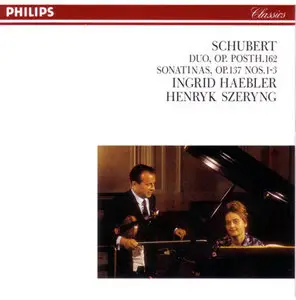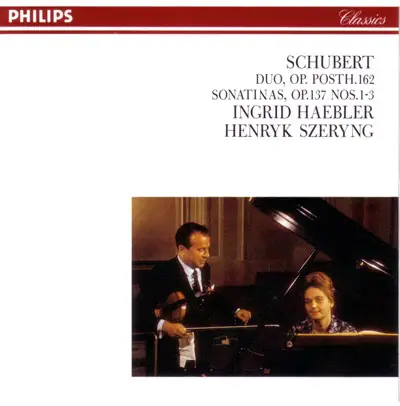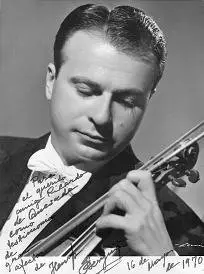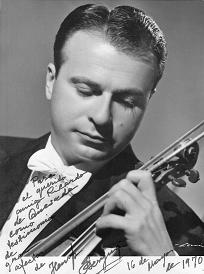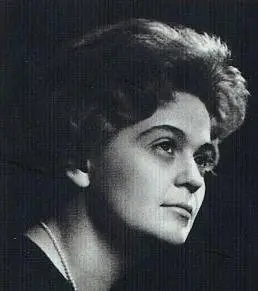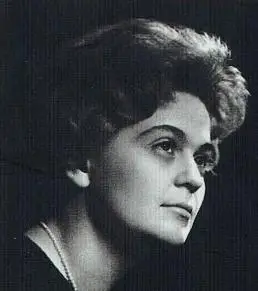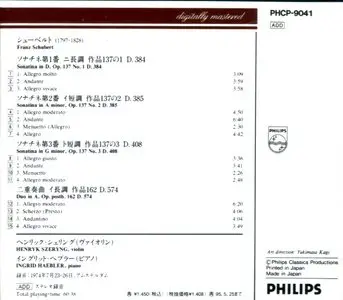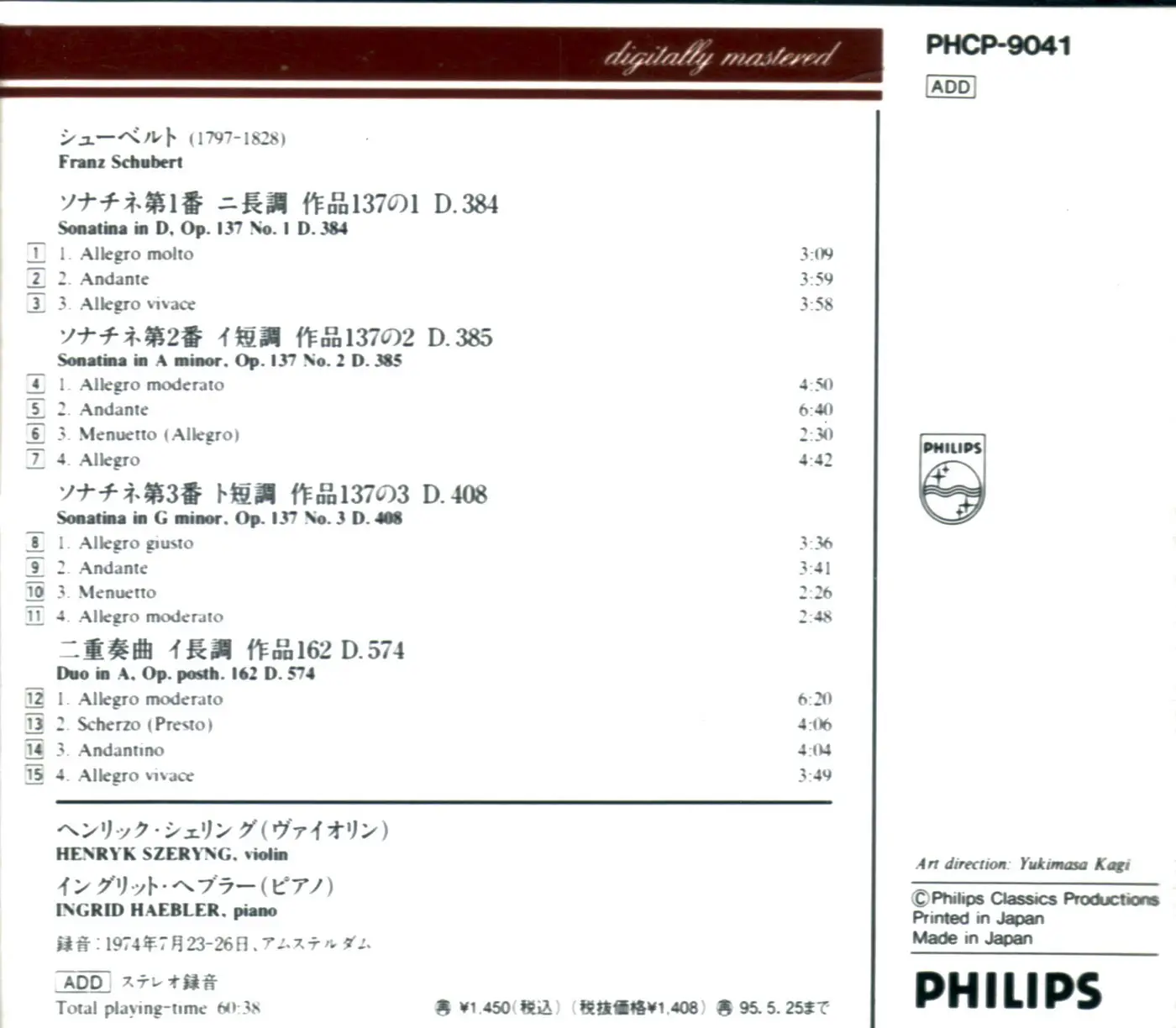Schubert: Duo, Op. Posth.162 Sonatinas, Op. 137 Nos.1-3 / Henryk Szeryng, Ingrid Haebler (1995)
EAC rip | FLAC, log, cue, covers | RAR Rec. 3% | 283 MB | hotfile, fileserve
Classical | Label: Philips | Time: 1:01
EAC rip | FLAC, log, cue, covers | RAR Rec. 3% | 283 MB | hotfile, fileserve
Classical | Label: Philips | Time: 1:01
Henryk Szeryng
He commenced piano and harmony training with his mother when he was 5, and at age 7 turned to the violin, receiving instruction from Maurice Frenkel; after further studies with Flesch in Berlin (1929-32), he went to Paris to continue his training with Thibaud at the Conservatory, graduating with a premier prix in 1937.
On Jan. 6, 1933, he made his formal debut as soloist in the Brahms Concerto with the Warsaw Philharmonic With the outbreak of World War II in 1939, he became official translator of the Polish prime minister Wladyslaw Sikorski's government-in-exile in London; later was made personal government liaison officer. In 1941 he accompanied the prime minister to Latin America to find a home for some 4,000 Polish refugees; the refugees were taken in by Mexico, and Szeryng, in gratitude, settled there himself, becoming a naturalized citizen in 1946. Throughout World War II, he appeared in some 300 concerts for the Allies. After the war, he pursued a brilliant international career; was also active as a teacher. In 1970 he was made Mexico's special adviser to UNESCO in Paris. He celebrated the 50th anniversary of his debut with a grand tour of Europe and the U.S. in 1983. A cosmopolitan fluent in 7 languages, a humanitarian, and a violinist of extraordinary gifts, Szeryng became renowned as a musician's musician by combining a virtuoso technique with a probing discernment of the highest order.
Ingrid Haebler
The esteemed Austrian pianist, Ingrid Haebler, came to the piano as a little girl, begining her musical training with her mother, and making her public debut in Salzburg at the age of 11. She then pursued her studies with Scholz at the Salzburg Mozarteum (1940-1942; 1948-1949) and with Weingarten (1943-1947) and Hauser (1952-1953) at the Vienna Academy of Music. She also attended the master-classes of Nikita Magaloff at the Geneva Conservatory (1950-1951; Prix de Virtuosite, 1951) and of the French pianist Marguerite Long at the Paris Conservatory (1953). In 1952 she was co-winner of the 2nd prize at the Geneva Competition (no 1st prize was awarded), and in 1954 she took 1st prize in both the Munich Competition and the Geneva Schubert Competition. She won the Harriet Cohen Beethoven Medal in 1957.
Ingrid Haebler then appeared with many of the leading orchestras of the day and at the principal festivals. In 1959 she made her USA debut as soloist with the Minneapolis Symphony Orchestra. She also appeared as a recitalist and chamber music player. As a duo recitalist, she often performed with the violinist Henryk Szeryng.
From 1969 to 1971 Ingrid Haebler was a professor at the Salzburg Mozarteum. She was awarded the Mozart medals of Vienna in 1971 and of the Salzburg Mozarteum in 1980, and in 1986 she received the Medal of Honor of Vienna.
Ingrid Haebler is considred as one of the 20th century's leading interpreters of the Viennese classic piano composers. In addition to her admired interpretations of Mozart, she has won distinction for her performances of Johann Christian Bach (on the fortepiano), Haydn, Beethoven, Schubert, Schumann, and Chopin.
While she has toured widely, Ingrid Haebler has made her international reputation with her finely judged recorded performances. These include all of Mozart's piano concertos, in two traversals of that cycle, all of Mozart's piano sonatas, all of Schubert's sonatas, and significant amount of the piano music of Haydn and Beethoven. In addition to these Vienna-linked composers, she has made notable Schumann and Chopin series as well. One reason her recordings are so effective is a reason she sometimes disappoints in person: Her playing is very intimate, creating a personal effect that can sound unassertive in the vastness of modern concert halls. On records, however, this same quality often makes a personal connection with the listener. Then the warmth, sensitivity, and quietly nuanced expressivity of her interpretations come into play. She records for Philips, which at the end of the 1990's was re-releasing some of her finest recordings on their Great Pianists series.
Tracklisting:
01. Sonatina in D, Op.137 No.1 D.384 - I. Allegro molto <3:15>
02. Sonatina i D, Op. 137 No.1 D.384 - II. Andante <4:01>
03. Sonatina in D, Op. 137 No.1 D.384 - III. Allegro vivace <4:08>
04. Sonatina in A minor, Op. 137 No.2 D.385 - I. Allegro moderato <4:54>
05. Sonatina in A minor, Op. 137 No.2 D.385 - II. Andante <6:43>
06. Sonatina in A minor, Op. 137 No.2 D.385 - III. Menuetto (Allegro) <2:32>
07. Sonatina in A minor, Op. 137 No.2 D.385 - IV. Allegro <4:52>
08. Sonatina in G minor, Op. 137 No.3 D.408 - I. Allegro giusto <3:42>
09. Sonatina in G minor, Op. 137 No.3 D.408 - II. Andante <3:45>
10. Sonatina in G minor, Op. 137 No.3 D.408 - III. Menuetto <2:29>
11. Sonatina in G minor, Op. 137 No.3 D.408 - IV. Allegro moderato <3:00>
12. Duo in A, Op.162 D.574 - I. Allegro moderato <6:24>
13. Duo in A, Op.162 D.574 -II. Scherzo (Presto) <4:09>
14. Duo in A, Op.162 D.574 - III. Andantino <4:07>
15. Duo in A, Op.162 D.574 - IV. Allegro vivace <3:54>
EAC extraction logfile from 14. October 2006, 22:23 for CD
Henryk Szeryng, Ingrid Haebler / Schubert - Sonatina Op.137 Nos.1-3, Duo Op. 574
Used drive : SONY CD-RW CRX230E Adapter: 1 ID: 0
Read mode : Secure with NO C2, accurate stream, disable cache
Read offset correction : 6
Overread into Lead-In and Lead-Out : No
Used output format : Internal WAV Routines
44.100 Hz; 16 Bit; Stereo
Other options :
Fill up missing offset samples with silence : Yes
Delete leading and trailing silent blocks : No
Installed external ASPI interface
Range status and errors
Selected range
Filename I:\CDImage.wav
Peak level 83.7 %
Range quality 100.0 %
CRC C82D864A
Copy OK
No errors occured
End of status report
Henryk Szeryng, Ingrid Haebler / Schubert - Sonatina Op.137 Nos.1-3, Duo Op. 574
Used drive : SONY CD-RW CRX230E Adapter: 1 ID: 0
Read mode : Secure with NO C2, accurate stream, disable cache
Read offset correction : 6
Overread into Lead-In and Lead-Out : No
Used output format : Internal WAV Routines
44.100 Hz; 16 Bit; Stereo
Other options :
Fill up missing offset samples with silence : Yes
Delete leading and trailing silent blocks : No
Installed external ASPI interface
Range status and errors
Selected range
Filename I:\CDImage.wav
Peak level 83.7 %
Range quality 100.0 %
CRC C82D864A
Copy OK
No errors occured
End of status report
hotfile | fileserve
No mirror, please


